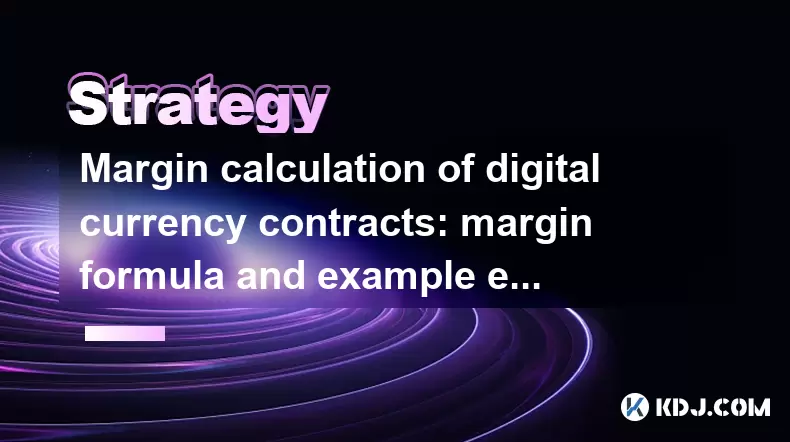-
 bitcoin
bitcoin $120167.907534 USD
1.27% -
 ethereum
ethereum $4468.611945 USD
2.53% -
 xrp
xrp $3.013607 USD
1.80% -
 tether
tether $1.000549 USD
-0.01% -
 bnb
bnb $1092.592149 USD
6.28% -
 solana
solana $231.391244 USD
4.59% -
 usd-coin
usd-coin $0.999699 USD
-0.04% -
 dogecoin
dogecoin $0.259020 USD
4.30% -
 tron
tron $0.342747 USD
0.34% -
 cardano
cardano $0.860977 USD
1.07% -
 hyperliquid
hyperliquid $50.155412 USD
5.34% -
 chainlink
chainlink $22.637678 USD
0.46% -
 ethena-usde
ethena-usde $1.000528 USD
-0.07% -
 avalanche
avalanche $30.613779 USD
-0.07% -
 stellar
stellar $0.403905 USD
0.94%
Margin calculation of digital currency contracts: margin formula and example explanation
Margin in digital currency contracts is collateral traders deposit to open positions, calculated as Contract Value x Margin Rate, crucial for leveraging and risk management.
Jun 04, 2025 at 10:42 am

Margin calculation in digital currency contracts is a critical aspect of trading, as it determines the amount of funds traders must hold to open and maintain positions. Understanding the margin formula and how it applies to real-world examples can significantly enhance a trader's ability to manage risk and optimize their trading strategy. In this article, we will delve into the intricacies of margin calculation for digital currency contracts, providing a detailed explanation of the margin formula and a practical example to illustrate its application.
Understanding Margin in Digital Currency Contracts
Margin in the context of digital currency contracts refers to the collateral that traders must deposit to open a position. This collateral acts as a guarantee to the exchange that the trader can cover potential losses. The margin requirement is typically a percentage of the total contract value, and it varies depending on the volatility of the underlying asset and the leverage offered by the exchange.
The concept of margin is crucial because it allows traders to leverage their positions, meaning they can control a larger position with a smaller amount of capital. However, this also increases the risk, as small price movements can lead to significant gains or losses.
The Margin Formula
The margin formula for digital currency contracts can be expressed as follows:
[ \text{Margin} = \text{Contract Value} \times \text{Margin Rate} ]
Where:
- Contract Value is the total value of the position, calculated as the number of contracts multiplied by the contract size and the current market price.
- Margin Rate is the percentage of the contract value that must be held as collateral.
This formula is straightforward but requires an understanding of each component to apply it correctly in different scenarios.
Components of the Margin Formula
Contract Value
The contract value is determined by the size of the contract and the current market price of the underlying asset. For example, if you are trading Bitcoin futures with a contract size of 1 BTC and the current price of Bitcoin is $30,000, the contract value would be:
[ \text{Contract Value} = 1 \text{ BTC} \times \$30,000 = $30,000 ]
Margin Rate
The margin rate is set by the exchange and can vary based on several factors, including the volatility of the asset, the leverage offered, and the trader's account type. For instance, an exchange might require a margin rate of 10% for a highly volatile asset like Bitcoin.
Example of Margin Calculation
To illustrate how the margin formula works in practice, let's consider a specific example. Suppose you want to open a position in Bitcoin futures with the following details:
- Number of Contracts: 2
- Contract Size: 1 BTC
- Current Market Price: $30,000
- Margin Rate: 10%
First, we calculate the total contract value:
[ \text{Contract Value} = 2 \text{ Contracts} \times 1 \text{ BTC/Contract} \times \$30,000/\text{BTC} = $60,000 ]
Next, we apply the margin rate to determine the required margin:
[ \text{Margin} = $60,000 \times 0.10 = $6,000 ]
In this example, you would need to deposit $6,000 as margin to open the position.
Types of Margin
There are different types of margin that traders should be aware of when trading digital currency contracts:
Initial Margin
Initial margin is the amount required to open a new position. This is the margin calculated using the formula provided earlier.
Maintenance Margin
Maintenance margin is the minimum amount of margin that must be maintained in the account to keep the position open. If the account balance falls below this level due to market movements, the trader will receive a margin call.
Variation Margin
Variation margin refers to the additional funds that may be required to be deposited if the market moves against the trader's position. This ensures that the account maintains the required margin level.
Margin Calls and Liquidation
Understanding the mechanics of margin calls and liquidation is essential for managing risk in digital currency trading. A margin call occurs when the account balance falls below the maintenance margin level. At this point, the trader must deposit additional funds to meet the margin requirement or close part of their position to restore the margin level.
If the trader fails to meet the margin call, the exchange may initiate liquidation of the position to cover the losses. This process involves automatically closing the position at the current market price, which can result in significant losses if the market has moved unfavorably.
Practical Considerations for Margin Trading
When engaging in margin trading of digital currency contracts, traders should consider several practical aspects to manage their positions effectively:
- Risk Management: Always use stop-loss orders to limit potential losses. Set these orders at levels that allow for market fluctuations but protect your capital.
- Leverage: Be cautious with leverage. While it can amplify gains, it can also lead to substantial losses. Use leverage judiciously based on your risk tolerance and market conditions.
- Monitoring: Keep a close eye on your positions and market movements. Digital currency markets can be highly volatile, and quick action may be required to manage margin calls.
- Diversification: Avoid putting all your capital into a single position. Diversify your portfolio to spread risk across different assets.
Frequently Asked Questions
Q1: How does the margin rate affect the amount of leverage a trader can use?The margin rate directly impacts the leverage a trader can use. A lower margin rate means a trader needs less collateral to open a position, allowing for higher leverage. Conversely, a higher margin rate requires more collateral, which reduces the leverage available.
Q2: Can the margin requirements change after opening a position?Yes, margin requirements can change based on market conditions and decisions made by the exchange. Traders should stay informed about any changes to margin requirements, as these can affect their positions and necessitate additional funds.
Q3: What happens if a trader cannot meet a margin call?If a trader cannot meet a margin call, the exchange will liquidate the position to cover the losses. This can result in the trader losing the entire margin deposit if the market moves significantly against their position.
Q4: How can traders avoid margin calls?Traders can avoid margin calls by monitoring their positions closely, maintaining a buffer above the maintenance margin level, and using stop-loss orders to limit potential losses. Additionally, understanding market volatility and adjusting leverage accordingly can help manage risk effectively.
Disclaimer:info@kdj.com
The information provided is not trading advice. kdj.com does not assume any responsibility for any investments made based on the information provided in this article. Cryptocurrencies are highly volatile and it is highly recommended that you invest with caution after thorough research!
If you believe that the content used on this website infringes your copyright, please contact us immediately (info@kdj.com) and we will delete it promptly.
- BlockDAG, DOGE, HYPE Sponsorship: Crypto Trends Shaping 2025
- 2025-10-01 00:25:13
- Deutsche Börse and Circle: A StableCoin Adoption Powerhouse in Europe
- 2025-10-01 00:25:13
- BlockDAG's Presale Buzz: Is It the Crypto to Watch in October 2025?
- 2025-10-01 00:30:13
- Bitcoin, Crypto, and IQ: When Genius Meets Digital Gold?
- 2025-10-01 00:30:13
- Stablecoins, American Innovation, and Wallet Tokens: The Next Frontier
- 2025-10-01 00:35:12
- NBU, Coins, and Crypto in Ukraine: A New Yorker's Take
- 2025-10-01 00:45:14
Related knowledge

Practical parameter settings for a Bitcoin multi-timeframe moving average system
Sep 18,2025 at 10:54pm
Optimizing Timeframe Combinations for Bitcoin Trading1. Selecting appropriate timeframes is crucial when building a multi-timeframe moving average sys...

How can I filter out false breakouts in Dogecoin high-frequency trading?
Sep 22,2025 at 01:00am
Understanding False Breakouts in Dogecoin Trading1. A false breakout occurs when Dogecoin's price appears to move beyond a defined support or resistan...

Techniques for identifying tops and bottoms in the Bitcoin on-chain NVT model
Sep 20,2025 at 07:54pm
Understanding the NVT Model in Bitcoin Analysis1. The Network Value to Transactions (NVT) ratio is often described as the 'P/E ratio' of the cryptocur...

What does the surge in open interest in Bitcoincoin futures mean?
Sep 20,2025 at 11:18pm
Understanding the Surge in Dogecoin Futures Open Interest1. A surge in open interest within Dogecoin futures indicates a growing number of active cont...

How can I use the Ethereum USDT premium to gauge market sentiment?
Sep 18,2025 at 11:55pm
Understanding the Ethereum USDT Premium1. The Ethereum USDT premium refers to the price difference between USDT (Tether) traded on Ethereum-based plat...

What should I do if Ethereum staking yields decline?
Sep 20,2025 at 06:18am
Understanding the Causes Behind Declining Ethereum Staking Yields1. The Ethereum network transitioned to a proof-of-stake consensus mechanism with the...

Practical parameter settings for a Bitcoin multi-timeframe moving average system
Sep 18,2025 at 10:54pm
Optimizing Timeframe Combinations for Bitcoin Trading1. Selecting appropriate timeframes is crucial when building a multi-timeframe moving average sys...

How can I filter out false breakouts in Dogecoin high-frequency trading?
Sep 22,2025 at 01:00am
Understanding False Breakouts in Dogecoin Trading1. A false breakout occurs when Dogecoin's price appears to move beyond a defined support or resistan...

Techniques for identifying tops and bottoms in the Bitcoin on-chain NVT model
Sep 20,2025 at 07:54pm
Understanding the NVT Model in Bitcoin Analysis1. The Network Value to Transactions (NVT) ratio is often described as the 'P/E ratio' of the cryptocur...

What does the surge in open interest in Bitcoincoin futures mean?
Sep 20,2025 at 11:18pm
Understanding the Surge in Dogecoin Futures Open Interest1. A surge in open interest within Dogecoin futures indicates a growing number of active cont...

How can I use the Ethereum USDT premium to gauge market sentiment?
Sep 18,2025 at 11:55pm
Understanding the Ethereum USDT Premium1. The Ethereum USDT premium refers to the price difference between USDT (Tether) traded on Ethereum-based plat...

What should I do if Ethereum staking yields decline?
Sep 20,2025 at 06:18am
Understanding the Causes Behind Declining Ethereum Staking Yields1. The Ethereum network transitioned to a proof-of-stake consensus mechanism with the...
See all articles










































































